May/June 2014
When Side Mirrors are Curb Feelers
From the Dordogne to Brittany and then on to Cornwall
We have always maintained that everything we bring along with us must do at least two things in order to earn its place…
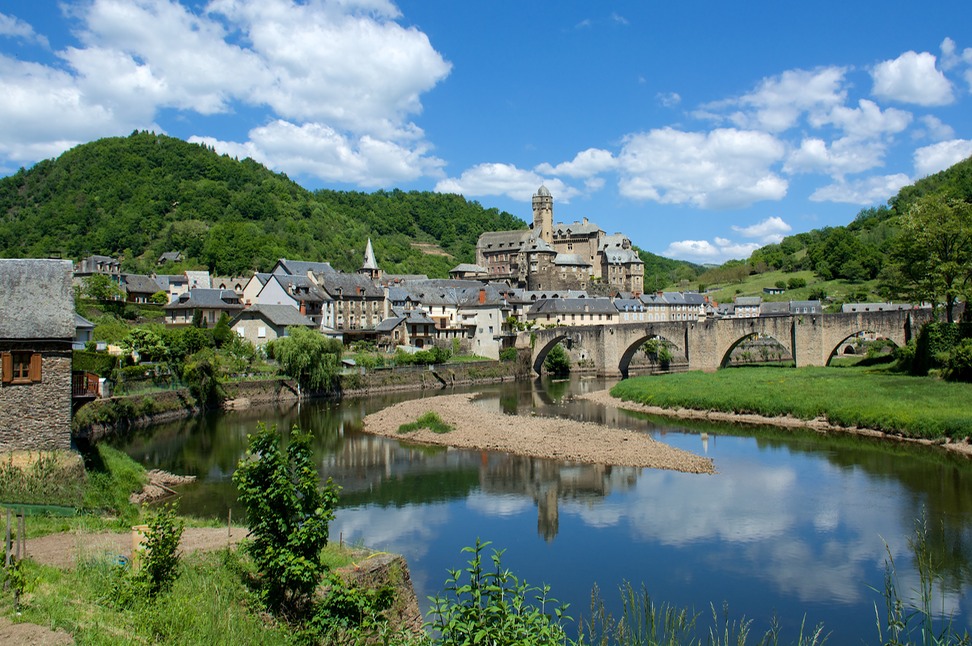
When last we wrote, we had just dropped down out of the Massif Central, that beautiful and wild area in the middle of France. We’d found warmer climes (well…somewhat) and begun our slow march north and west toward Brittany and, eventually, England.
Of course getting there would take a bit of time, and there would be plenty to see and enjoy along the way. We had moved into the region of the Aveyron, Dordogne and Lot river valleys, one of the most popular areas of France, especially for expats looking for places to settle. This is a fantastic area to explore, with intense history, great natural beauty and many unspoiled areas to visit. We could, and probably should, have spent far longer here than we did.
We began by following the River Lot, moving east to west through the southern part of the region, through old villages with even older castles on the hillsides above town; crossed ancient bridges still shut down from time to time to allow the farmers to move the cows to higher pasture; and enjoyed being in an area where the local occitane patois appeared on all the signs. This is the French Midi, to the north of Provence and the Cote d’Azur. The stone is a lovely creamy color, the architecture of the churches and other buildings differs from the rest of France, and the town squares are more reminiscent of piazzas. At times we were sure that we were back in Italy. The local strawberries have been ripening, along with the cherries – and they are available everywhere.
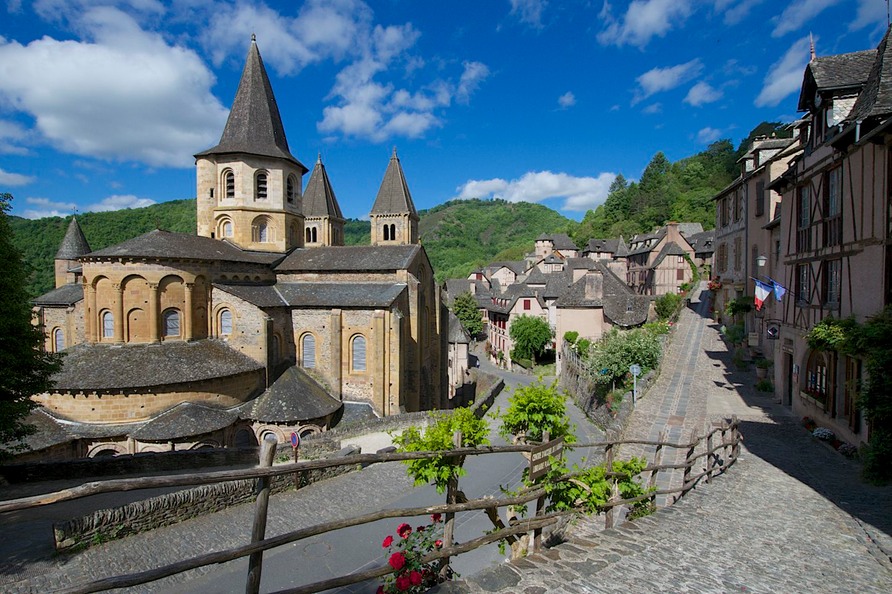
We wandered along quiet small roads connecting the towns of Espalion, Estaing, and Conques and this area particularly captured our fancy. Each town was special in its own way, nestled in greenery along the lovely river. Espalion offered wonderful views of buildings and bridges reflected in the still waters, while Estaing was even more lovely sitting on a curve in the river with its castle towering over everything else. Along the small country lane connecting the two we found one of those perfect, sunny meadows we love so much, where we stopped for a day and a night in near solitude. In Conques we discovered a completely different but equally charming town, this time nestled in the mountains high above the river; charming and picturesque and seemingly isolated from the cares of the world, this is a really cool place; a perfect quiet getaway spot if you are looking for such. We were blessed with clear skies for several days and just enjoyed the heck out of our time in this little area.
Keeping to a westerly course but changing valleys, we next moved to Villfranche-de-Rouergue in the valley of the Aveyron. This is a still largely unspoiled town with a marvelous sloping bastide square surrounded by arcades and fronting an imposing church whose massive tower seems all the more grand due to the pitch of the cobbled square.
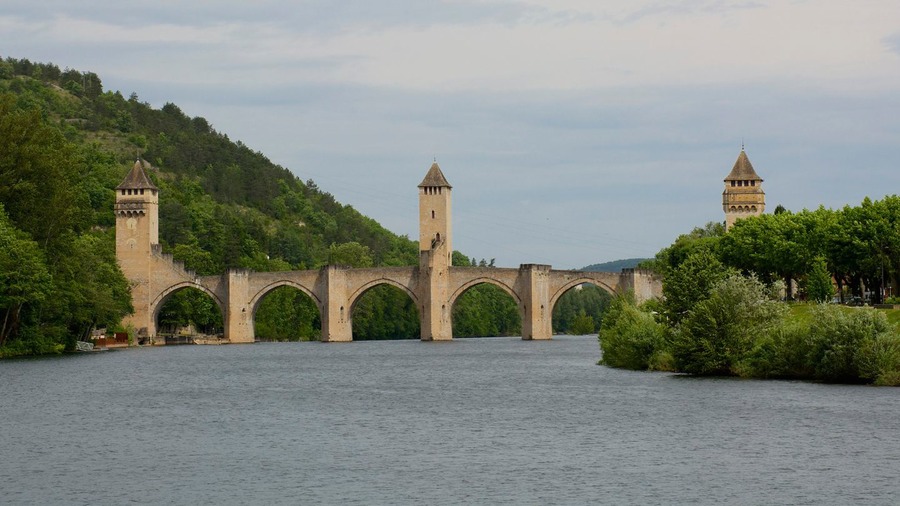
Continuing our tour back on the Lot, we were only able to pause in Cahors for pictures of its most famous landmark, the Pont Valentré, a beautiful towered medieval bridge, as we were not able to find a place to park for a longer visit. (We double-parked while Rick ran across the street to get a few more photos before we left.) Further west, we wandered back out into vineyard country, towards the bastide towns of Monflanquin and Montpazier. Bastides are fortified towns that popped up everywhere throughout this region during the Hundred Years War between England and France in the thirteenth and fourteenth centuries -- the region between the Lot and the Dordogne Rivers was a disputed frontier area separating the warring factions. The bastides were originally designed to organize the towns as a way for the ruling lords to both improve defense and to increase their profits by making better “use” of the local farmers. The architecture is reminiscent of Italy, the central squares very Italian in feel, even the colors of the stone and the stucco walls take you back to Umbria. The local churches are quite unique as well, as they are fortified with four-foot thick walls. We saw several of these towns, with Montpazier the prettiest.
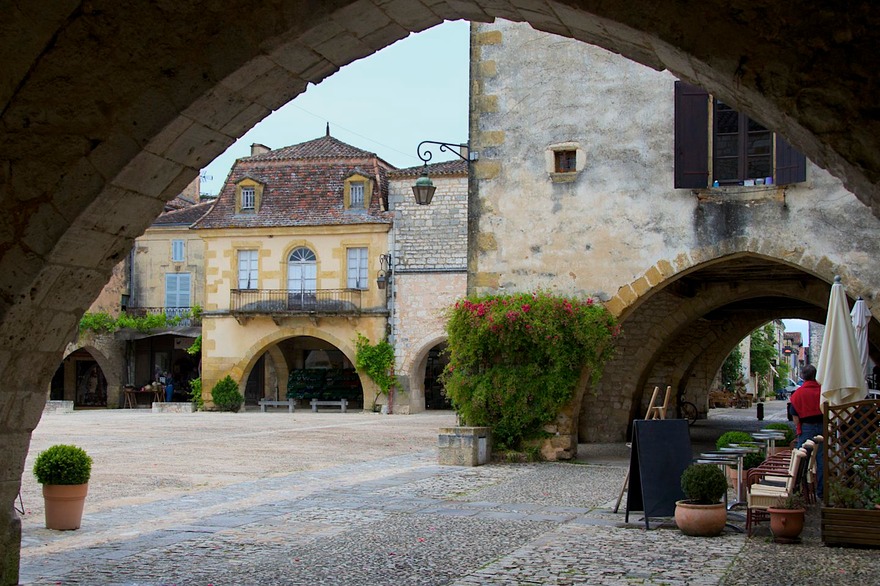
We spent a couple of nights in the parking lot for the town of Montpazier, and chatted with others of the motorhoming population passing through. We shared a proper English tea (on china!) with an English couple who spend about 10 months each year in France, a not-uncommon event it would seem. They know France well, and were up-to-date on their info. They even had a book called The 500 Most Beautiful Small Villages in France, and we suspected they had been to most of them. It was mind-boggling just to contemplate the task!
Looping eastward and switching now to the valley of the Dordogne, we did a drive-by of lovely Beynac-et-Cazenac. We would have stopped to explore this town that had been featured in the movie Chocolat, with its really cool fortress on the hillside, but we were starting to get into an area with oodles of folks doing the same thing we were. We did stop in nearby Souillac, with its weird church carvings of animals eating people and each other, stuff like that – actually we saw several churches with similar motifs; very “fires of hell” and quite fascinating -- and in isolated and tiny St-Amand-de-Coly, we explored an extraordinarily beautiful and tiny village blessed with an enormous Romanesque church. It was so old that the entry steps had been completely worn down, with deep grooves where, over the years people had walked. But we determinedly stayed away from the largest of the attractions of the area.
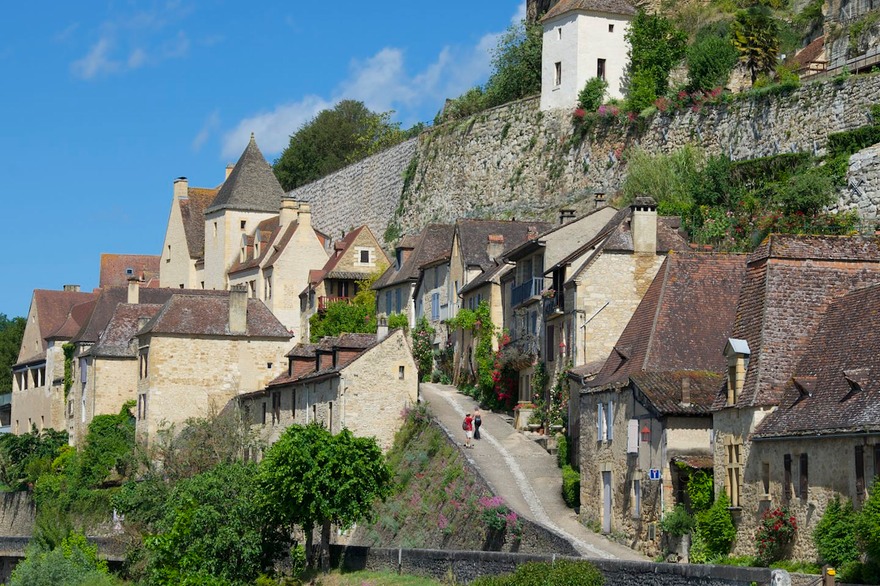
Unfortunately, tempus continued to fugit as it does and it was time for us to head up out of these river valleys and continue our progress toward Brittany. As always, our visa clock was ticking and we were running out of days to see what we wanted to before we had to board the ferry to England. We had reached the borders of the Perigord region; there were as many signs for paté and truffles as for its many ancient cave paintings and the roads and stopping points were becoming crowded; we had decided to skip the cave paintings for this round, and we needed to move on to explore different, and quieter, territory.
Climbing up out of the Dordogne Valley we were once again moving west and north and emerged onto the vast open plains that typify France north of the mountains. Huge acreage planted in grapes, wheat, rape (but the beautiful yellow flowers were all gone now) and similar crops was quite typical. We started to get rain again, after having enjoyed a stretch of clear, warm weather, and it began to hail. Well! Not on our agenda! But we slogged through it all, heading for the town of Aulnay. Our Rough Guide said that the church there, l’Eglise de Saint Pierre, was rather special; once again, RG did not disappoint. The church is a beautiful building set in a large cemetery with lots of open space around it while the interior is very other-worldly, with more of these nasty, people-eating animals carved expressively into the stone; we were entranced. (Wonder why we’re so taken by animals eating people?) We conducted out visit between raindrops, with the wind blowing in our faces; it seemed to suit the mood.
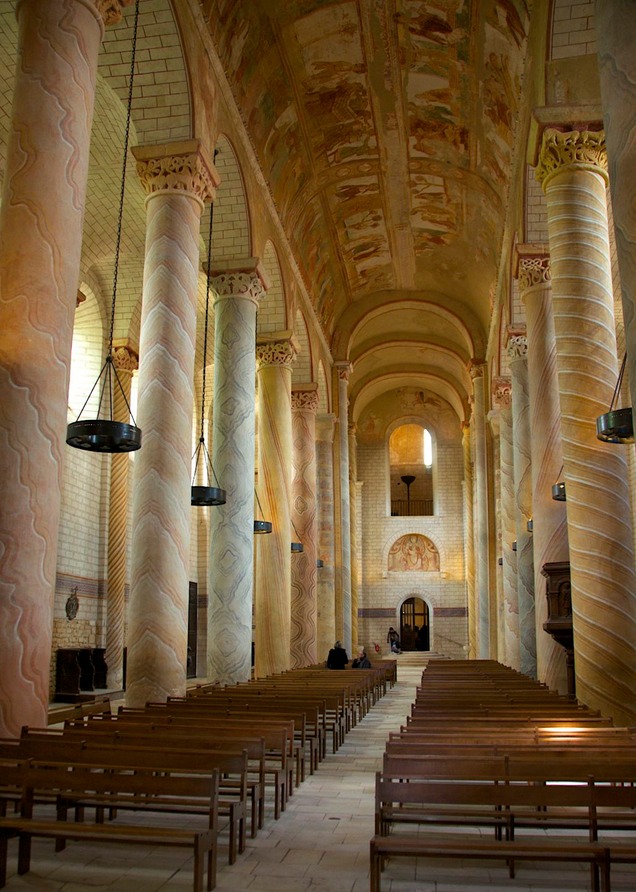
Moving on, we visited two other nearby towns, Chauvigny and St. Savin, both just east of Poitiers. Chauvigny boasts the ruins of five medieval castles ranging along a ridgeline above the bustling city, presenting an imposing skyline for sure. St. Savin could not be more different; just a small hamlet really, but possessing an amazing church dating from the eleventh century which is now a UNESCO site. The interior is gloriously painted in free-form designs with some more structured paintings as well. It is a beautiful and special place. It took us awhile to get used to the wild designs, as we’d not seen such “loud” decorations in French churches before, but since then we’ve visited other churches with just whispers of those same designs that are left over from the original paint job, so we’ve learned to appreciate them. A different look for sure.
We spent a night in the small town of Lezay on our route, a nice quiet night in a public parking area on the edge of this small town (do you begin to see the repetition -- “nice quiet” and “small town”?). The next morning we woke up surrounded by ducks and geese and rabbits and live eels (very large, very live and very slithery), along with fresh produce and cheese and flowers and all the usual stuff. It was a large regional market. Such a hoot! Knowing the geese were being sold so they could become paté dampened our enthusiasm a bit, otherwise the scene was just great. We bought strawberries and petted the rabbits and ducks (and oh, yes, there were doves too) and oh! I forgot the snails. Escargot, ya know.
We dipped very briefly into the western edge of the Loire Valley, stopping for the night in Richelieu and going into the charming town the next morning, looking for internet. We had definitely left medieval France and were well into the 17th century. And… lots more people. The Loire of course is famous for its numerous grand chateaux, but it’s really far too mainstream for our tastes. We fled.
Into Brittany. We’d looked forward to being here and hoped to see a different France. This far-western corner of the country has a history and reputation all its own – Celtic, rural, behind the rest of the world, quaint, quiet, intriguing, with signs in two languages -- how cool! We’d managed to set aside about a week to explore the area before catching the ferry from the Breton port town of Roscoff over to Plymouth, across the Channel.
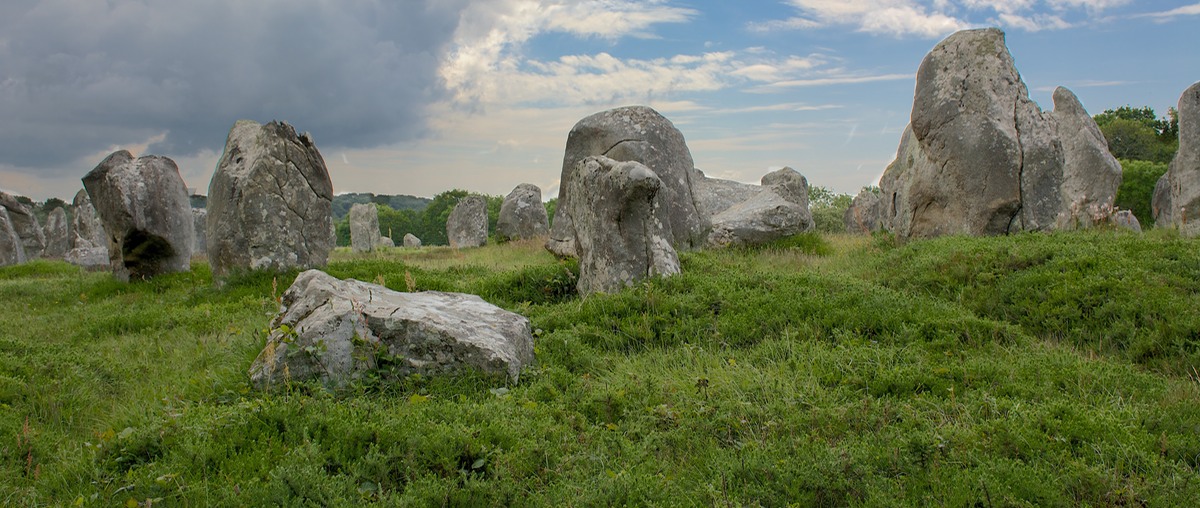
Well, hmmm. Brittany. We did have fun, and we saw some very interesting architecture, along with some really cool ancient stones (menhirs). And the countryside is nice. But we think we’re about 25 years too late. The rest of the world has discovered the nice weather and great beaches and (perhaps at one time) bargain prices. Again too many folks. But that’s just us, of course, silly ole’ Rick and Kathy, who want quiet vistas with unimpeded views, no schlock, etc.
The highlight for me was getting to the megalithic stones at Carnac. We’ve seen stone circles and other fascinating configurations before, in England, Ireland, Scotland, Denmark, etc. These are unique (actually every stone construct is unique unto itself) by generally having been erected in long lines of stones that eventually converge around a central area. They were carved from local rock, numbering around 3,000 originally, and many of them are pretty darn big. They are way cool. They are protected, of course, and the land management folks have started grazing a local variety of sheep in some areas, to keep the gorse and other weeds under control. All of this is somewhat controversial, naturally. You used to be able to wander among the stones at will, but now it’s more controlled. But still really neat. I had a lot of fun poking around.
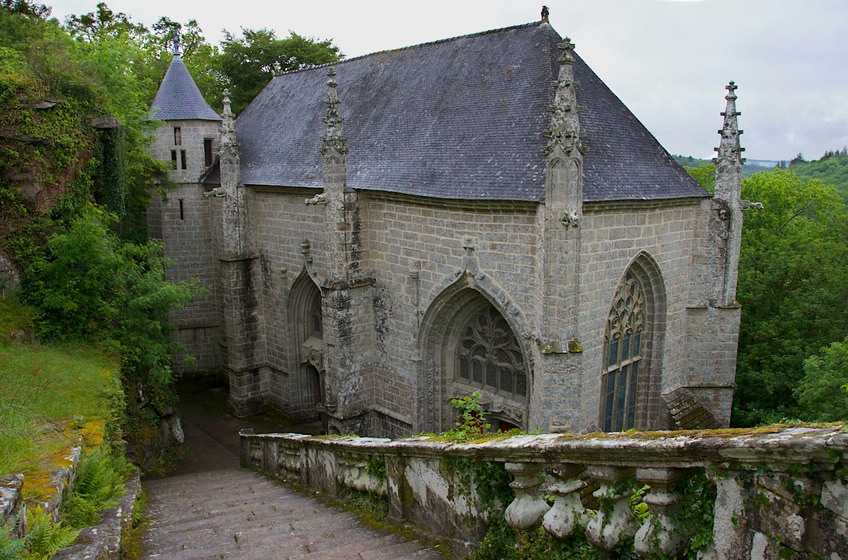
Also cool, we saw some unique architecture in the local churches. These are very Celtic in nature, and have a completely different feel from those we had been seeing. The one we liked the best was the Chapelle Sta. Barbe near Le Faouë. It was in a small, quiet glen, buried in moss, and reeking of atmosphere. Mostly built around 1500, it wasn’t large, but what a treat!
Two other great churches were at St-Thégonnec and Guimiliau. These are noteworthy because of their incredible stone carvings on the exteriors and in the small closes (entry courtyards) featuring the tortures of the damned (yet again). They were really special; we thought we were back in Ireland, the Gaelic influence was so strong.
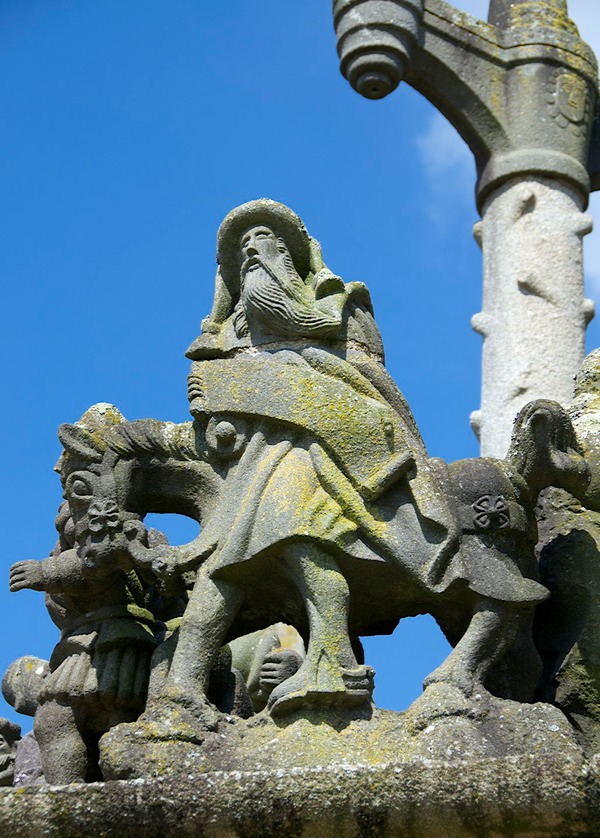
We trekked out to the western end of France, beyond Brest to Le Conquet, once a quaint fishing village but now more of a souvenir stand and day-trip stopover. We have read many a sailing adventure story that figured in this area, and wanted to see for ourselves. Ushant is quite famous in British maritime accounts. It sits offshore, a small island that the French call Île d’Ouessant. Equally evocative is the name the Pointe de Raz. These were very important landmarks for sailors needing to keep off the French coast. In actuality, we weren’t able to get very close to these spots, just too much hoopla.
Too, we were running out of time. We’d only seen the western part of Brittany, but had to get going. It was beginning to be apparent that we’d need to come back this way in the fall to pick up where we had left off. We made our ferry reservations, and took care of a couple of chores. We had our latest adventure with a European medical system, this time French. Last winter Rick had had some routine blood work done, and the doctor had requested a follow-up to be done about now. Knowing that England could be more expensive for these things, we had decided to try and get it handled before we crossed the Channel.
Turns out it was easy. We got advice on a good clinic to go to, and did. They weren’t willing to do the tests on the orders of our American doctor, but sent us to a nearby doctor for a French version. He was delightful, fit us in between patients, wrote out new orders, and sent us off, free of charge! I love that man! We went back to the clinic and Rick was in and out in less than half an hour. The results would be ready at the end of the day. Poof, and we were gone! Total cost? 42 euros, or about 59 bucks. We mailed everything to California and were delighted to cross that errand off our list.
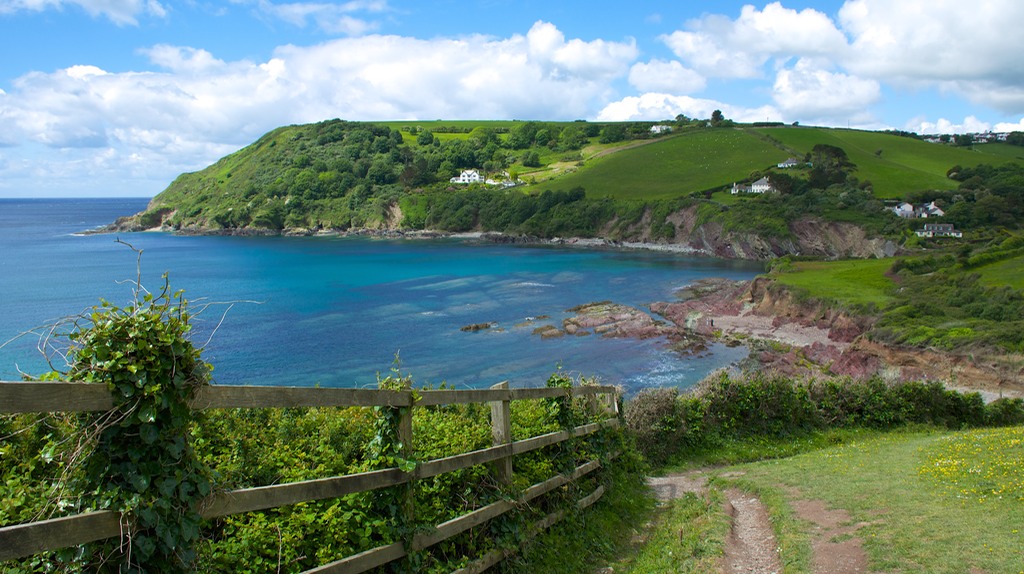
We had an early morning ferry out of Roscoff for the 6-hour ride to Plymouth, so we headed for the port the night before. We could have stayed in the waiting area, but it was a real zoo, so we retreated back into the village, finding a nice quiet place for the night parked up near their old cemetery. The boat ride was peaceful, and we spent the time preparing for our visit to Cornwall.
Our first really big plans for our British summer were to visit London (at last – it’s only taken us four years). But we’d also never been to Cornwall and I still remember all those wonderful romance novels I’d read that took place there; gotta go!!
So we went. And, yes we had some good – even delightful – times. But once again, Cornwall is no longer cute and quaint and remote and rural and full of heroes rescuing damsels, etc. All that good stuff has been replaced. Just as with Brittany, there are too many people who have discovered that it’s sunny and warm and there are great beaches; cute and quaint is now overwhelmingly cutesy and touristy. I should have been warned when, while talking to a crowd of French high school students on the ferry, I learned that they were all heading for a holiday at Penzance.
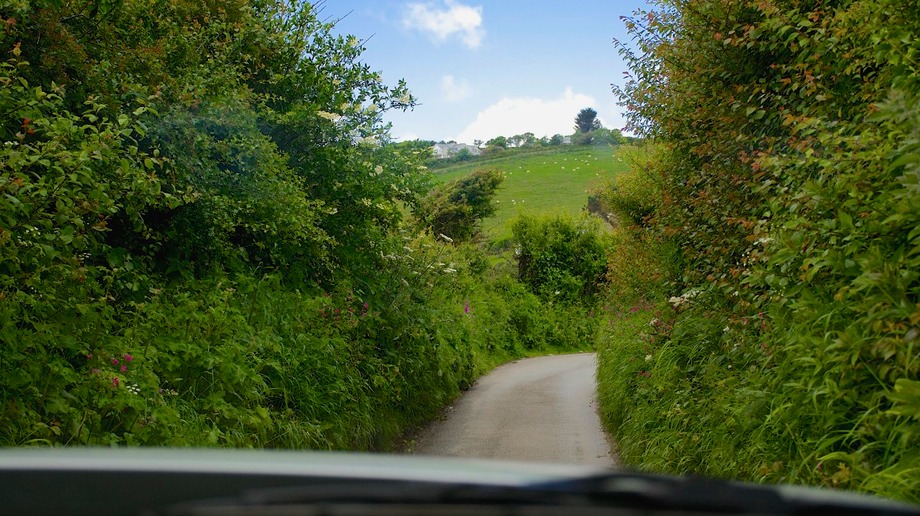
And, of course, the roads are famously narrow and hard to drive. Rick was reminded of “the olden days” when cars had curb feelers. Here in Cornwall, just as in parts of Brittany, our side mirrors were doing double duty. We ventured down one tiny road after another, and they took us to some lovely places, but those mirrors did extraordinary duty helping Rick stay in his lane. Just as on our earlier trips to Britain, it was necessary at times to keep the driver’s side mirror just skimming along the high hedge running along the left side of the road in order to keep the right side tires from bumping along on the reflective centerline dots. This of course is on the two-lane sections of roadway with traffic coming the other way. (By the way, the normal speed limit on these little two-lane roads is 60 mph.) Even though we only manage about 40 it’s quite an adventure skimming along around a blind curve not knowing what might be coming up around the bend. On the one-way sections we’ll sometimes have both mirrors touching the hedges, going much more slowly of course. We’d find some of those curb feelers and mount them on the mirrors but then we wouldn’t fit at all.
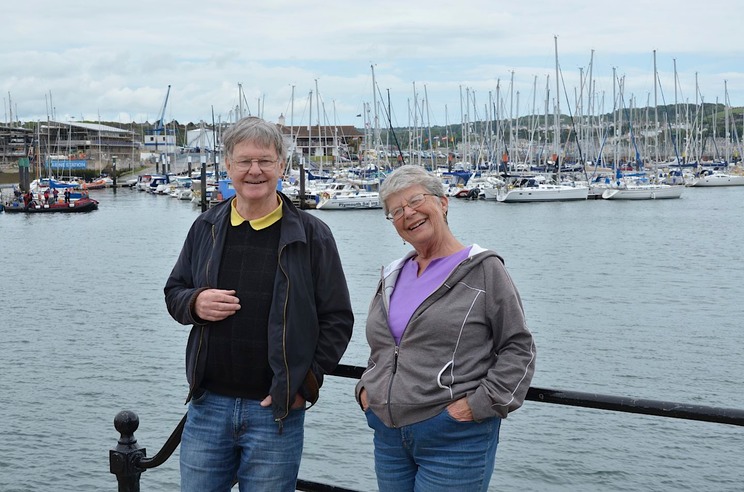
But we did enjoy ourselves, keeping to areas that were out of the way and had no known attraction to bring in the buses. It was fun. Southern England is just about as pretty a place as there is in this world of ours. The wild rhododendrons are in bloom – absolutely everywhere. They are huge and quite astounding.
But, we get ahead of ourselves. We landed in Plymouth, a very nice spot. Down by the old wharf, you can wander and see several monuments to different groups who have famously departed the old sod from this location. The stone stairs the Pilgrims used to step down to water level and climb on board the Mayflower in 1620 are nicely maintained and available to stand on. We found lovely fish and chips, which we enjoyed with Rick’s cousin Des, our English mailman. (We always have our mail sent to him just before we come to England; he takes the train and meets us somewhere and we have a lovely reunion; he’s very dear to us, and not just for the excellent mail service.)
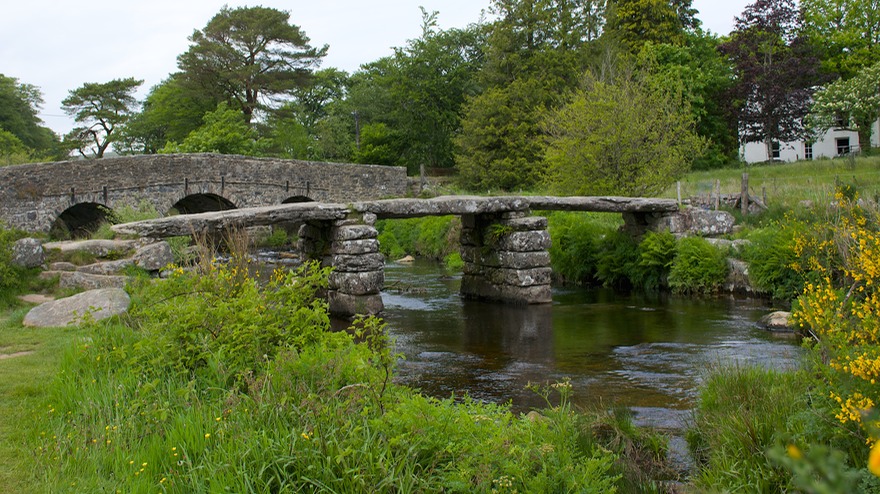
Des had suggested we shouldn’t miss Dartmoor National Park, and were we glad he’d mentioned it. It was both beautiful and very interesting. We entered from the west, into a rather desolate area at first, but soon found forests, wandering glades with lovely streams past fields filled with fat sheep. This is a large park, with plenty of room for all who might be there, and we enjoyed it.
We stopped to check out clapper bridges. These are ancient, made of large slabs of stone placed across a stream on stone pilings, quite picturesque of course. You could walk across some of them; others looked pretty unstable. We spent the night in a grassy parking area overlooking a canyon; during the evening we had a great thunder and lightening show and woke in the morning surrounded by misty hillsides. Emily (our GPS) joined us from time to time while we were at Dartmoor. “Too many trees,” she said. “I keep getting lost; I’m so happy to find you…” Sadly, I saw more of the countryside than Rick did – the roads were narrow and difficult, as they are throughout southern England, and constantly bordered by tall hedges; like driving in a tunnel. And then you have to share with other traffic, including the ever-present cyclists who take their lives in their hands whilst traveling these tiny roads.
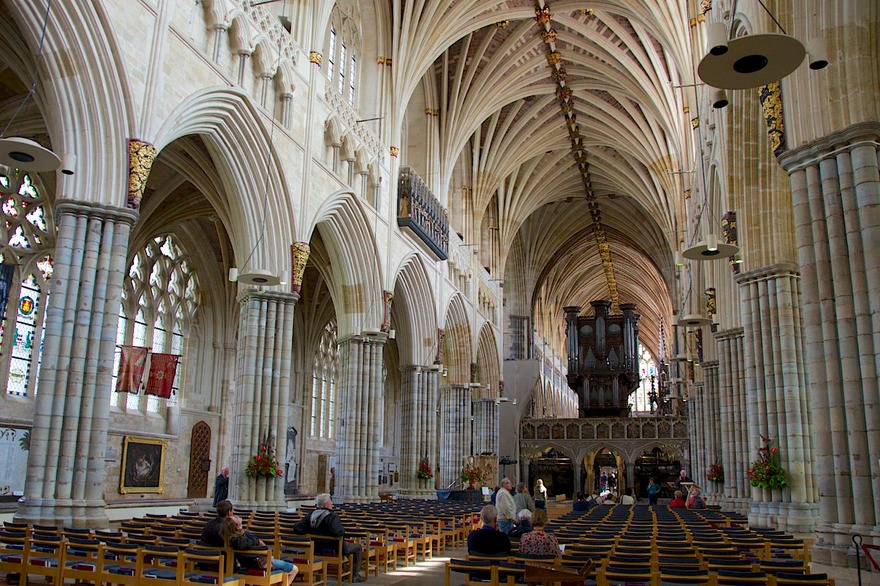
Leaving the park, we made a beeline for Exeter and its beautiful cathedral. This was our first English church in a couple of years; we’d been hanging out in Germany, Italy and France. In some ways the English were far more restrained than those other folks, but when you consider the amazing architecture and how dramatic it is, perhaps not all that restrained after all; just different. We loved it and felt welcomed back as we began another round of visits to fine English cathedrals.
Moving in the general direction of London, we had lots of choices for route, and lots of sights we wanted to see, not having spent any time in this area in years past. But we also had decided that our long-term plans for this year would have us going right back to France in September, to finish Brittany and see Normandy. This being the case, a smart move might be to come back south through this same corridor and take the ferry back to Roscoff. Therefore, we could set some things aside to see later and not have to rush through them on the way to London, where our dates were fixed. Also it was early June and the summer equinox was approaching, so places like Stonehenge and Avebury would hopefully be quieter later in the year.
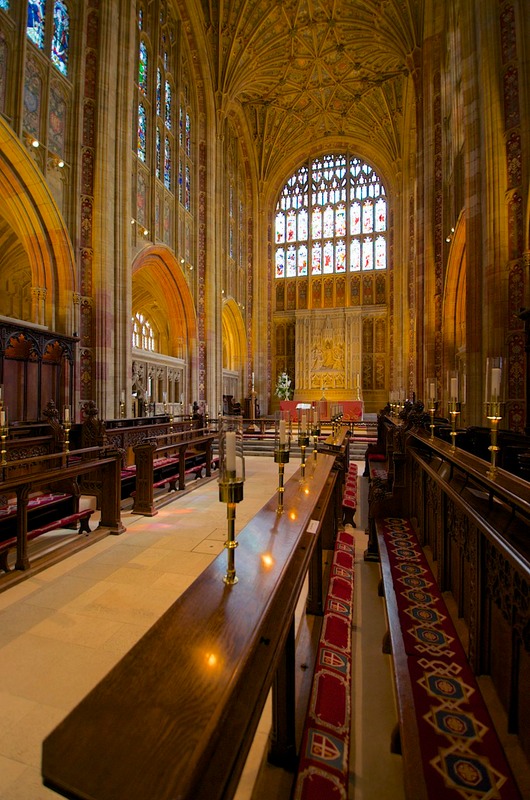
This is what we thought; we’ll see how it works out later.
So instead, we stopped in Sherborne, just about the most perfect place we’ve ever seen. The beautiful abbey and surrounding area, nice parks, pretty town, it all got really high marks. We could take up housekeeping there. The abbey is just phenomenal; exquisite, with lovely golden stone and marvelous decoration.
Leaving Sherborne, heading east toward Salisbury, we passed Fovan. Why, you say? To see the Regimental Badges marked out in white on the hillside near there, of course. Totally cool. Why are they there? Haven’t a clue. But a large green hillock is covered with them, and they are very impressive. Go see for yourself! (Actually, to be quite truthful, I think I was the only one really impressed, but Rick was happy to stop for me to get out and get an eyeful, good man that he is.)
We spent a very nice sunny Sunday afternoon in Salisbury. Their cathedral was quite spectacular and very welcoming. We wandered around town enjoying this and that. Our guidebook (RG again) had suggested we might want to stick our heads in the door of St Thomas church, so we did. Unexpectedly, there was an honor guard of the British Legion in full regalia with flags and banners, about to begin a rededication ceremony. It was quite colorful and interesting.

I wanted some pictures of the church and didn’t feel comfortable taking them during the ceremony, so I stopped back a couple of hours later, and had the entire church to myself. It was really an interesting place. And… there were lots of regimental banners hanging from the ceiling – some of the insignia on the flags were the same as what I’d seen on the hillside near Fovan. So there!
London loomed, and we weren’t ready. We knew of a quiet spot out in the country, and we spent a couple of lovely, sunny days there. It was on the edge of a midden (prehistoric mound), and we had hikers and dog walkers for company. Absolutely perfect. Two days later, armed with notes and plans and maps and as ready as we could make ourselves for the London Experience, we revved up La Tortuga and headed for the London ring road. It was June 10th. Did we conquer London? Stay tuned!
Hugs and kisses from Rick and Kathy and L’Entourage